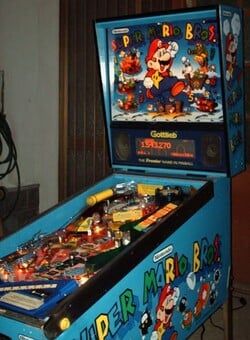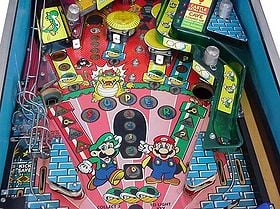Super Mario Bros. (pinball)
| Super Mario Bros. | |
|---|---|

| |
| Developer | Gottlieb |
| Publisher | Gottlieb |
| Release date | Template:Release[?] |
| Genre | Fictional Licensed theme |
| Mode(s) | Four players |
| Cabinet | Cabinet made of plywood |
| Monitor | Dot-matrix display |
| Input | Pinball |
Super Mario Bros. is a pinball machine developed by Gottlieb and licensed by Nintendo. It was released in the United States on April 25, 1992, and a total of 4,200 units was manufactured.[1] The machine was designed by Jon Norris, with artwork by David Moore and Constantino Mitchell. It was the first pinball machine produced by Gottlieb to use the dot-matrix display, a screen on the bottom of the lightbox that keeps track of the current score and can also display various animations during gameplay (such as Mario running towards a castle). Being one of America's top 10 best-selling pinball games of 1992, the game received a Gold Award from the American Amusement Machine Association.[2] Despite the name "Super Mario Bros.," the machine appears to share a majority of its artwork with Super Mario World, released two years before. A second pinball machine in the Super Mario Bros. series was released in June later in the year under the name Super Mario Bros. Mushroom World, which seems to be based on Super Mario Bros. 3.[3]
Playfield layout
The pinball machine contains many Mario-themed interactive features, such as on-field artwork that lights up during gameplay and the main objective of rescuing the princess. There are three flippers, the third found at the top of the playfield on a raised, separate Yoshi-themed area. Underneath this raised area is Luigi's cave. A revolving blue castle is located at the top of the playfield, which the player is able to "destroy" by shooting at it while "Super Mario." This can be achieved by lighting up the letters that spell "SUPER," located near the middle of the playfield. The castle has an artwork of Bowser on the top. A kick save is found on the left outlane. Yellow and blue Warp Pipes on either side of the middle act as slingshots, which powerfully eject the ball soon after it enters. Four sinkholes are seen throughout the playfield, most providing points or a bonus, depending on the situation. Two are seen on either side of the field just below the slingshots: one above the third flipper on a raised platform at the top of the playfield, and one just in front of the castle. This sinkhole has a plastic tube that runs down to the bottom right hole just above the right slingshot. A wireform ramp leads from the top sinkhole and drops the ball into the left inlane. A few of the sinkholes are able to light up one of the letters that spell "SUPER." There are three pop bumpers on the top half of the field. These pop bumpers toggle the lights to different types of bonuses the player may receive on the five spot targets.[4]
Rules and gameplay
The aim of the game is to become Super Mario by spelling "SUPER," which then allows the player to shoot for the castle. Destroying seven castles in seven different worlds rescues the princess, and the player is then able to enter their name and score. They will receive a replay if the high score to date is beaten. All castles destroyed will be carried over to the next game. This makes it possible to begin a game with six castles, and the player will need to destroy only one to win. However, the score would be significantly lower in comparison to gameplay throughout all seven worlds. The player is initially given three balls, but more can be gained during play.
Bonus rounds

The game consists of six different rounds, which provide temporary objectives in the game that can reward points for completing certain tasks. In order to play a round, the player must light three shells, which can be done by hitting spot targets or ramp shots where shells are lit. After doing so, the player must obtain the Key by getting the ball into one of the three sinkholes when the Key light has been lit. The player can then select with the flippers which round they wish to play. If it is not selected within a few seconds, the system will choose whichever round the player is currently selecting. The six rounds and their descriptions are as follows:
- Bomb round – The player must light the Bob-omb fuse by hitting the left ramp spot target while the bomb insert is flashing. After doing so, the player must shoot the ball into any of the sinkholes to gain 30 million points. The upper playfield sinkhole also stays lit for the rest of the ball, being worth 20 million points.
- Mega Bumpers round – The player simply needs to hit each pop bumper to score a bonus one million points.
- Yoshi's Countdown round – The player must hit Yoshi's spot target on the raised upper playfield to collect the countdown value, which begins at 24 million and slowly decreases. The value does not count down during multiball (see below section).
- ! Round – The player needs to hit the "!" targets to collect increasingly higher scores. The scores range from 1, 2, 3, 5, and finally 10 million.
- Castle Extra Ball round – The player must enter the castle during this round to collect an extra ball.
- Cave Count-Up round – The player needs to hit the spot targets within the area known as Luigi's cave. The player collects a count-up value with each hit, which stops at 48 million.
Entering a round as Super Mario doubles the value of that round, including extra balls. Each round lasts for only about a minute. Once a round has been completed, it cannot be played again during the same game. Completing all six rounds in a game lights Castle Special.
Multiball
To achieve multiball, the player must light 1-2-3-4 in sequence. Each number is situated within a different area of the playfield: "1" is on the left ramp, "2" is the Yoshi target in the raised area, "3" is the right loop shot that feeds the ball back into the bumpers, and "4" is the shot made from the third flipper on the raised platform. Once those shots have been made, the player must hit the ball into the bottom left sinkhole to gain the multiball. There are two types of multiball: 2-ball and 3-ball. The latter can be played by being Super Mario when multiball is gained. The object of multiball is to get as many balls into the castle as possible. Each ball in the castle earns a jackpot, which begins at five million. As multiple balls enter the castle, the jackpot increases to 10, 20, and finally 40 million. Additionally, this total is increased during 3-ball.
Video mode
The game's video mode is shown after the ball has entered the castle and the Bullet Bill sequence is complete. The dot-matrix display seen on the lightbox shows what appears to be a classic Super Mario Bros. game, where the player runs and jumps across gaps in the ground with a flagpole and castle seen at the end. The right flipper is used to jump, while the left one is used to run faster. 10 million points are awarded for making it to the end; if the player holds the left flipper in for the whole level, the game will award 30 million points instead. When the last castle has been destroyed and the ball has drained, Mario runs across the screen towards the castle. If the player makes him jump during that sequence, they will also receive 30 million points instead of the normal 10 million.
Staff
License and supervision
Production
Design
- Jon Norris
Artwork
- David Moore
- Constantino Mitchell
Dots and animation
- Rand Paulin
- Daryl Moore
Software
- Allen Edwall
- Rand Paulin
Voice
- Charles Martinet (supposedly)[5]
Gallery
Logos and flyers
Machine cabinet
Backglass artwork. Wart appears here, and "Bowser" is really a design based on King Koopa from the DiC Entertainment television cartoons.
Playfield
View of the Yoshi ramp
Detail of Bowser artwork. He has blue eyes in this illustration.
Detail of Princess Toadstool artwork
Detail of Green Shell artwork
Promotional artwork
Mario riding Yoshi
Glossary
- For a glossary on pinball terms, see here.
References
- ^ Internet Pinball Database: Super Mario Bros.
- ^ Play Meter Volume 19 no. 5. April 1993. ACME '93: Play Meter, AAMA present awards. Pgs. 74–76.
- ^ Internet Pinball Database: Super Mario Bros. Mushroom World
- ^ Doug's Home Arcade Collection (December 6, 2016). SUPER MARIO BROS. PINBALL MACHINE - BY GOTTLIEB 1992. YouTube. Retrieved March 1, 2020.
- ^ https://pinside.com/pinball/forum/topic/nintendo-pinball-mystery-solved-voice-of-mario-in-super-mario-bros-




















